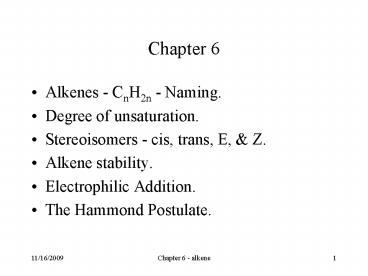Alkenes CnH2n Naming' - PowerPoint PPT Presentation
1 / 52
Title:
Alkenes CnH2n Naming'
Description:
electrophile (Lewis acid) (Minor) 9/12/09. Chapter 6 - alkene. 32. Electrophilic Addition - examples. Markonikov's Rule. regiospecific. Predict major product: ... – PowerPoint PPT presentation
Number of Views:119
Avg rating:3.0/5.0
Title: Alkenes CnH2n Naming'
1
Chapter 6
- Alkenes - CnH2n - Naming.
- Degree of unsaturation.
- Stereoisomers - cis, trans, E, Z.
- Alkene stability.
- Electrophilic Addition.
- The Hammond Postulate.
2
Alkene - CnH2n
ethene or ethylene
propene or propylene
3
Alkene - CnH2n
trans-2-butene
cis-2-butene
2-Methlypropene
4
Alkene - CnH2n
1-Pentene
2-Pentene
2-Pentene
?-
?-
2-Methyl-1-butene
5
Alkene - CnH2n
4,7-Dimethyl-2,5-octadiene
3-Methylcyclohexene
3,4-Diisopropyl-2,5-dimethyl-3--hexene
6
Alkene - CnH2n
2,3-Dimethylcyclopentene
4,4-Dimethylheptene
7
Chapter 6
- Alkenes - CnH2n - Naming.
- Degree of unsaturation.
- Stereoisomers - cis, trans, E, Z.
- Alkene stability.
- Electrophilic Addition.
- The Hammond Postulate.
8
Degree of Unsaturation.
Page 270, problem 7.44
Compound A has the formula C8H8. It reacts
rapidly with KMnO4 to give CO2 and a carboxylic
acid, B (C7H6O2), but reacts with only 1 molar
equivalent of H2 on catalytic hydrogenation over
a palladium catalyst. On hydrogenation under
conditions that reduce aromatic rings, 4
equivalents of H2 are taken up, and hydrocarbon C
(C8H16) is produced. What are the structures of
A, B, and C? Write the reactions.
9
Degree of Unsaturation.
10
Rules for Degree of Unsaturation.
See page 191.
11
(No Transcript)
12
(No Transcript)
13
etc.
14
Given the oUS many possibilities.
Given the oUS composition possibilities
reduced.
Given the oUS, composition, chemical
information often compounds identity can be
determined.
15
Degree of Unsaturation.
Page 270, problem 7.44
Compound A has the formula C8H8. It reacts
rapidly with KMnO4 to give CO2 and a carboxylic
acid, B (C7H6O2), but reacts with only 1 molar
equivalent of H2 on catalytic hydrogenation over
a palladium catalyst. On hydrogenation under
conditions that reduce aromatic rings, 4
equivalents of H2 are taken up, and hydrocarbon C
(C8H16) is produced. What are the structures of
A, B, and C? Write the reactions.
16
Chapter 6
- Alkenes - CnH2n - Naming.
- Degree of unsaturation.
- Stereoisomers - cis, trans, E, Z.
- Alkene stability.
- Electrophilic Addition.
- The Hammond Postulate.
17
Stereoisomers - cis, trans
p 196. Disustituted means two substituents other
than hydrogen that are bonded to the double-bond
carbons.
trans
cis
neither
18
Stereoisomers - E, Z.
Trisubstituted
Tetrasubstituted
19
Stereoisomers - E, Z.
high
high
low
high
low
low
low
high
E
Z
ze zame zide
(Z)-3-Methyl-2-pentene
(E)-2,2,3,4-Tetramethyl-3-hexene
20
Stereoisomers - E, Z.
Assign E or Z configuration
low
high
high
low
high
low
Z
low
high
Z
21
Chapter 6
- Alkenes - CnH2n - Naming.
- Degree of unsaturation.
- Stereoisomers - cis, trans, E, Z.
- Alkene stability.
- Electrophilic Addition.
- The Hammond Postulate.
22
Alkene Stability
Evidence heats of hydrogenation
Reasons hyperconjugation bond strength
23
Hyperconjugation
p 205.
interaction between the unfilled antibonding
C C? bond orbital and a filled C - H ? bond
orbital on a neighboring substituent...
The more subtituents that are present, the more
opportunities exist for hyperconjugation, and the
more stable the alkene.
24
Bond Strength
p 206.
More highly substituted alkenes always have a
higher ratio of sp3 - sp2 to sp3 - sp3 bonds than
less highly substituted alkenes and are therefore
more stable.
25
Heats of Hydrogenation - cis
26
Heats of Hydrogenation - trans
27
Heats of Hydrogenation - cis trans
28
Heats of Hydrogenation - cis trans reaction
profile
29
Chapter 6
- Alkenes - CnH2n - Naming.
- Degree of unsaturation.
- Stereoisomers - cis, trans, E, Z.
- Alkene stability.
- Electrophilic Addition.
- The Hammond Postulate.
30
Electrophilic Addition - symmetric
2o carbocation
nucleophile
electrophile
2o carbocation
(Lewis base)
(Lewis acid)
nucleophile
(Lewis base)
electrophile
only one product !!!!
(Lewis acid)
31
Electrophilic Addition - asymmetric
3o carbocation
nucleophile
electrophile
2o carbocation
(Lewis acid)
(Lewis base)
electrophile
(Lewis acid)
Markonikovs Rule
(Major)
nucleophile
(Lewis base)
regiospecific
(Minor)
electrophile
(Lewis acid)
32
Electrophilic Addition - examples
Predict major product
ether
33
Electrophilic Addition - examples
Predict major product
ether
34
Electrophilic Addition - examples
Predict major product
35
Electrophilic Addition - examples
Predict major product
ether
36
Electrophilic Addition - examples
Predict major product
ether
37
Electrophilic Addition - examples
Predict major product
ether
38
Stability of Carbocation
39
Evidence of Carbocation
minor
major
H-shift
40
Electrophilic Addition - examples
Predict all products
41
H-shift
42
Stability of Carbocation
- Inductive effect.
- Hyperconjugation
43
Inductive Effect
R is an alkyl group, larger and polarizable.
C
44
Hyperconjugation
45
Chapter 6
- Alkenes - CnH2n - Naming.
- Degree of unsaturation.
- Stereoisomers - cis, trans, E, Z.
- Alkene stability.
- Electrophilic Addition.
- The Hammond Postulate.
46
Experimental Data
heat
CH3CH2CH3 2Cl2 ? CH3CHClCH3 CH3CH2CH2Cl 2HCl
?
?
heat
CH3CH2CH3 2Br2 ? CH3CHBrCH3 CH3CH2CH2Br 2HBr
?
?
47
Experimental Data
heat
CH3CH2CH3 2Cl2 ? CH3CHClCH3 CH3CH2CH2Cl 2HCl
43
57
heat
CH3CH2CH3 2Br2 ? CH3CHBrCH3 CH3CH2CH2Br 2HBr
8
92
Regiospecificity stronger in Bromine and
Chlorine. Why?
48
Hammond Postulate
CH3CH3 Cl ? CH3CH2 HCl ?H -21 kJ/mol
CH3CH3 Br ? CH3CH2 HBr ?H 42 kJ/mol
49
Hammond Postulate
CH3CH2 ------- H -- Br
CH3CH2 -- H ------- Cl
CH3CH2 HBr
E
E
CH3CH3 Cl
-21kJ/mol
42 kJ/mol
CH3CH2 HCl
CH3CH3 Br
RC
RC
50
Carbocation
Ease of breaking 3o gt 2o gt 1o
51
Hammond Postulate Carbocation
E
RC
52
Chapter 6
- Alkenes - CnH2n - Naming.
- Degree of unsaturation.
- Stereoisomers - cis, trans, E, Z.
- Alkene stability.
- Electrophilic Addition.
- The Hammond Postulate.































